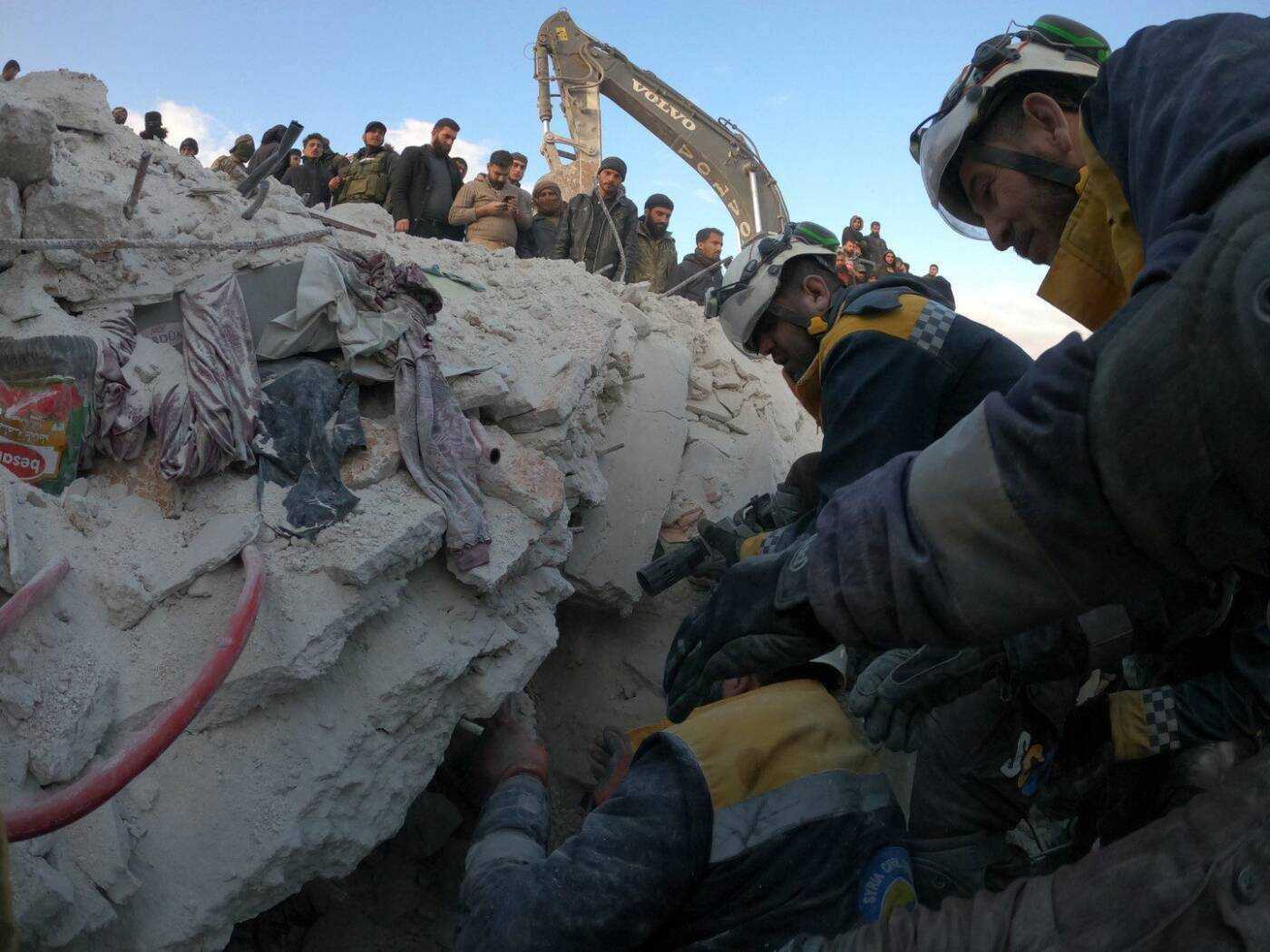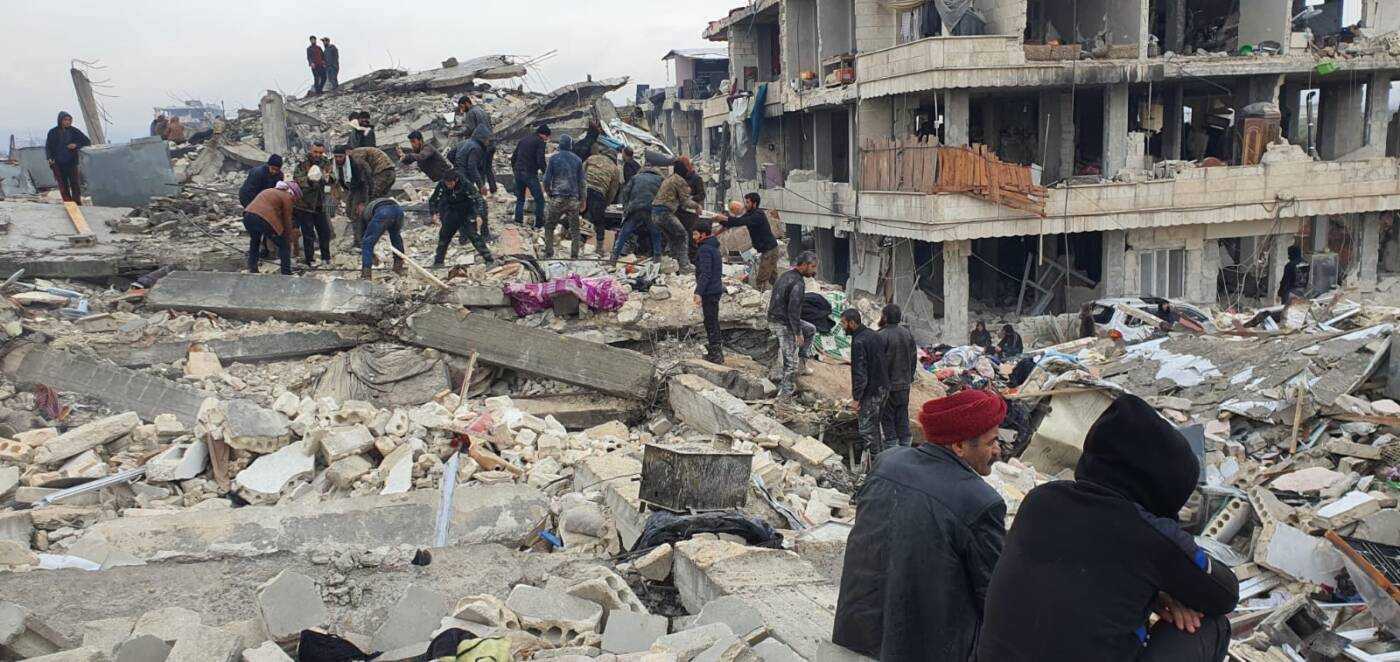‘Running out of breath’: Have Syrians been left to face the earthquake alone?
Rescue teams in several countries have mobilized to help Turkey rescue the victims of Monday’s devastating earthquake, but so far no aid or personnel have entered northwestern Syria, where residents are turning to displacement camps as a refuge.
7 February 2023
PARIS — As rescue efforts and aftershocks continue in northwestern Syria, fear of another major earthquake is driving many people to sleep in open squares, in their cars or flee cement buildings for displacement camps and temporary shelters.
Turkey’s Disaster and Emergency Management Authority (AFAD) has documented 312 earthquakes in less than 48 hours following the 7.7-magnitude quake that struck Turkey and Syria around 4 am on February 6, with its epicenter in southern Turkey’s Kahramanmaraş region.
Abd Almajed Alkarh, 26, spent Monday night with his wife and one-year-old daughter in his car, parked in an open square in Idlib city. Houses made of cement—long a dream for thousands of the two million displaced people who make up half the population of northwestern Syria—have become “unsafe havens,” he said, in the wake of Monday’s earthquake.
Over the past two days, “panic, fear and vast scenes of destruction” left Alkarh—who was displaced from the Damascus countryside city of Darayya in 2016—feeling that the bombardment and barrel bombings he survived both in his hometown and in Idlib were easier to bear than earthquakes.
“Bombing is concentrated on one area, which might give people the chance to escape to safety,” he told Syria Direct. “When an earthquake hits entire cities, where do you go?”
First responders are unable to cope with the full scale of the disaster in northwestern Syria, and no additional equipment, vehicles or rescue teams have entered the area since the earthquake first struck. “Aid has been promised, but none has arrived,” Munir Mustafa, Deputy Director of the Syrian Civil Defense, told Syria Direct on Tuesday.
So far, members of the Syrian Civil Defense (also known as the White Helmets), have rescued 2,400 injured people, while they have documented the deaths of 1,020 people, Mustafa said. “The numbers are likely to rise significantly, because there are hundreds of families under the rubble.”
More than 360 buildings have been entirely destroyed, and more than 1,000 have been partially destroyed, Mustafa added. There are also “dozens of areas we haven’t been able to respond to properly, and dozens of demolished buildings we have not been able to reach, because we aren’t able to deploy our teams to all the impacted areas.”
As of Tuesday, the Syrian regime’s Ministry of Health has also reported 812 deaths and 1,449 injuries in five provinces: Aleppo, Latakia, Hama, Tartous and the Idlib countryside.
And in Turkey, AFAD reported 3,432 deaths due to the earthquake as of Tuesday afternoon, as well as 21,103 injuries. On Monday, Catherine Smallwood, the World Health Organization’s chief emergency officer in Europe, told AFP that the death toll—at the time roughly 2,000 across Turkey and Syria—could increase eightfold.

Syrian Civil Defense volunteers conduct search and rescue operations in the Idlib countryside village of Besenya, 7/2/2023 (Syrian Civil Defense)
‘Like judgment day’
In the hours before dawn on Monday, journalist Mahmoud Hamza woke with a start to “strange sounds I was hearing for the first time, accompanied by an earthquake.”
At that moment, Hamza only thought of finding a safe place for himself, his wife and their children. They quickly left their house in the Atma area on the border with Turkey, heading for his father’s home nearby. “It is less dangerous than my house in the event of another earthquake, because it is built of mud, with a plastic insulation roof,” he told Syria Direct.
In Idlib city, the first moments of the earthquake were “like judgment day,” Alkarh recalled. “All the people in Idlib rushed out of their homes.” As a photographer, he is usually one of the first people to go cover any major event in the area. But on Monday, for the first time, he “froze up,” and it was several hours before he went out to survey damage in the area.
Afaf Jakmour, another journalist in Idlib, felt the same way. In the first moments, she felt “helpless, torn between the responsibility we have to report people’s tragedy and their suffering, and the fear we are going through,” she told Syria Direct.
Jakmour, Alkarh and Hamza are all journalists whose work has been published by Syria Direct.
Jakmour feels that her current situation is better than others in the area. Her building suffered minor damages, compared to the scenes of destruction in the area. But it does not feel safe anymore, especially as aftershocks continue, she said.
Cement buildings in northwestern Syria, as in Idlib city where Jakmour and Alkarh live, and in Atma where Hamza lives, were damaged during the earthquake. But seven kilometers away from Atma, the Jenderes district of Afrin, in the northern Aleppo countryside, was one of the worst-hit areas.
When the sun came up on Monday, Hamza headed to neighboring Jendereres. “Here was the shock. There is no district or neighborhood without a completely destroyed building,” while people were “following the sounds coming from under the rubble, in order to locate those who were trapped.”
For the first time, journalist Fadi Shubbat, who lives in the al-Muhammadiya camp in the Afrin countryside, six kilometers from Jenderes, felt fortunate to be living in a displacement camp.
Shubbat has been writing about his experiences in the camp, which he hopes to publish as a book entitled “Cemeteries of the Living.” He, too, visited Jenderes, where the earthquake brought concrete roofs down on residents, and “felt for the first time the positivity of living in the camp,” he said. “In the camp, you don’t have to leave your tent—you’re relatively safe, unless the ground were to cave in.”
Displacement camps have become a refuge for some fleeing harder hit areas. In Deir Balout, a camp of 1,500 tents that neighbors al-Muhammadiya where Shubbat lives, each tent “has received a family or two from the disaster areas, and the school has been turned into a temporary shelter,” he said.
‘Running out of breath’
Since Monday’s earthquake, several countries have rushed to announce their solidarity with the victims in Turkey and its neighbor, Syria. Rescue teams from multiple countries—including Italy, the Netherlands, Taiwan, France and Qatar—have mobilized to participate in search and rescue operations in the affected areas in Turkey.
At the time of publication, Syrian activists were circulating reports that Qatari rescue teams had arrived in northwestern Syria, coinciding with the Qatar Charity’s announcement of an air bridge to send urgent relief aid for the victims of the earthquake in Turkey and Syria.
However, multiple sources told Syria Direct that no rescue teams or equipment have entered the northwest. One source, who works in the humanitarian field and asked not to be named, said “there is no truth to reports of the arrival of Qatari or French rescue teams to Syria so far.”
Local civil defense teams are working to do all they can to deal with the impacts of the earthquake, but the machinery they have “is not sufficient to deal with this enormous scale of destruction,” civil defense deputy director Mustafa said. He estimated the shortfall in the machinery needed at more than 50 percent.
“People are running out of breath,” and local personnel cannot fully respond to the emergency, Mustafa said, calling for swift action by the international community. “Every second means saving a life. Civilians cannot be left to face their fate,” he added.
Until there is a response from the international community, individual states and organizations, “Syrians rely on each other,” Mustafa said.
Earthquake hits cross-border aid
Most humanitarian operations aimed at northwestern Syria operate out of southern Turkey, the area most severely impacted by the earthquake in that country. As a result, the earthquake has caused “confusion among humanitarian organizations and response teams, because they [themselves] are impacted,” said Mohamad Katoub, an expert in the field of Syrian humanitarian response and relief advocacy.
“Turkey, its hospitals and its logistical capabilities formed the back lines for northwestern Syria, when it faced disasters as a result of military operations. But today, they are damaged,” Katoub said. “They won’t be able to support efforts in Syria, to say nothing of the problem of supply lines between the two countries.”
So far, no precise damage assessment exists, and all efforts are focused on emergency response. But in any case, “the scene is more vast than we imagine, and more complicated,” Katoub said. He stressed that responding to the disaster is impossible “without urgent intervention by the United Nations,” which “must be in the form of response teams, not just aid.”
Over the past two days, northwestern Syria’s lack of capacity to cope with the earthquake “drove civilians to take part in rescue operations and search for survivors,” Idlib journalist Hamza said. But “if countries [such as Turkey] need help to remove the rubble, how about a devastated and destroyed area like northwestern Syria, that already doesn’t have the ability?”
This report was originally published in Arabic and translated into English by Mateo Nelson.







